Performance Analyses of Energy Detection Based on Square-Law Combining in MIMO-OFDM Cognitive Radio Networks
Abstract
:1. Introduction
- The development of a new mathematical formulation for the ED of MIMO-OFDM signals based on the SLC method;
- The introduction of developed algorithms for simulating ED performance using SLC for the signals transmitted in MIMO-OFDM systems with different combinations of PU (Tx) and SU (Rx) branches (antennas); and
- The investigation of the impact of different parameters such as Tx powers, modulation types, the number of samples used for ED, the level of false alarm probability, and the number of MIMO Tx-Rx branches (antennas) on the detection probability of the signals detected using the SLC ED method in MIMO-OFDM systems.
2. Related Works on the Spectrum Sensing of OFDM Signals Based on the ED Method
3. System Model and Energy Detection Principles
3.1. System Model
3.2. Energy Detection
3.3. Detection and False Alarm Probabilities
3.4. Detection Threshold
3.5. Number of Samples
3.6. Noise Variance
4. Algorithm for Simulating Energy Detection
| Algorithm 1. Generation of m×r MIMO OFDM signals. |
| 1: Input 1: Number of transmit antennas (m=M), number of Rx antennas (r=R), modulation order K (QPSK, 16 QAM, 64 QAM), number of samples (N), frame size (framelen), length of cyclic prefix (cp_len), range of SNR simulated values (SNR_loop), number of transmitted packets in each simulation run (packets number), the overall number of channels (L), reference constellation (refconst), normalization type (type), and Tx power (power). 2:Output: Received MIMO OFDM signal (mimo_ofdm_received_signal_M×r) 3: Initialize: Input1 4: FOR i = 1: SNR_loop; 5: SNR = SNR_loop (i); 6: NPW = 10^(-SNR/10); 7: FOR i = 1: packets number; Step 1:Generate vector of random data points for K-PSK or K-QAM modulation 8: x = randint (N, framelen, K); 9: Scale=modnorm (refconst, ‘type’, power); 10: S_Usr1=Scale*psk(qam)mod(x, K); Step 2: Perform transmission with STBCs 11: X= S_Usr1 [:, framelen]; Step 3: Perform IFFT 12: S_t_m= ifft(X); Step 4: Compute Cyclic Prefix; 13: S_t_cp_m= [ S_t_m (end-cp_len+1: end,:); S_t_m ]; Step 5: Parallel to serial transformation 14: s_tx_m= reshape(S_t_cp_ m, 1, framelen*(N + cp_len)); Step 6: Set channel transmission coefficients with fading 15: h_mr = 1/sqrt(2*M*(L+1))*randn(1,L+1); Step 7: Generation of transmitted signal in multipath channel 16: s_rx_r = 0; 17: FOR l = 1:L+1 18: s_rx_r = s_rx_r + h_mr*s_tx_m; 19: END Step 8: Impact fo noise on transmitted signal 20: n_r = (NPW/2)*randn(1, length(s_rx_r)); 21: s_rx_r_n = s_rx_r + n_r; Step 9: Reception of signal at r-th branch of SU 22: FOR r= 1:R 23: FOR k = 1:framelen 24: S_M×r = [s_rx_r_n ((N + cp_len)*(k-1)+1:(N + cp_len)*k) ]; 25: S_M×r_cp_r = S_M×r (cp_len + 1:end,:); 26: S_M×r_f_r = fft(S_M×r_cp_r); 27: END 28: END Step 10: FFT estimation of chanel matrix coeffcients 29: h_f_ M×r= fft([h_mr zeros(1,N-(L+1))].’); Step 11: Reception of signal at r-th branch after OFDM demodulation 30: FOR p = 1:N 31: H = [h_f_ M×r (p)]; 32: r_p = [S_ M×r _f_r (p,:)]; 33: mimo_ofdm_received_signal_M×r= r_p*H 34: END 35: END 36: END |
4.1. Algorithm for Simulating MIMO-OFDM Signal Generation and Reception
| Algorithm 2. ED process based on SLC for M×R MIMO-OFDM system. |
| 1: INPUT: mimo_ofdm_received_signal_M×r,number of samples (N), SNR_loop, DT factor (ρ′), NU factor (ρ), noise variance (, range ofand number of Monte Carlo simulations (kk) 2: OUTPUT: Probability of detection ( 3: ON INITIALIZED Received MIMO-OFDM signal (mimo_ofdm_received_signal_M×r) do: Step 1: Simulation of detection probability () vs. SNR based on (14), (15) 4: set kk = number of Monte Carlo simulations 5: set SNR_loop = signal to noise ratio [−25, 10] 6: FOR p = 1:length (SNR_loop) 7: i1= 0; 8: FOR i = 1:10, 000; Step 2: Modeling the impact of NU on the received signal 9: Noise uncertiaity ( >1.00) = sqrt().*randn (1, framelen); 10: received_signal_M×r = mimo_ofdm_received_signal_M×r + Noise uncertainty; Step 3: Received signal energy calculation based on SLC 11: REPEATE FOR r= 1:R 12: energy_calc_r = abs(received_signal_M×r).^2; 13: END Step 4: Test statistic calculation based on combining energies of R signals (based on (4)) 14: FOR r= 1:R 15: test_stat = sum(energy_calc_r); 16: END Step 5: Threshold evaluation (based on (12)) 17: thresh (p) = ((qfuncinv( (p)).* ρ./sqrt(N))+ ρ)./ ; Step 6: Decision making process 18: IF (test_stat >= thresh (p)); 19: i1 = i1 + 1; 20: END 21: END Step 7: Monte Carlo simulation-determining (based on (1)) 22: (p) = i1/kk; 23: END 24: UNTIL = [0, 1] |
4.2. Algorithm for Simulating Energy Detection in MIMO-OFDM System Based on SLC
5. Simulation Results
5.1. Simulation Software and Parameters
5.2. Impact of SISO and MIMO Transmission on the ED Performance
5.3. Impact of the Number of Samples on the ED Performance in MIMO-OFDM Systems
5.4. Impact of the Different Modulations on the ED Process in MIMO-OFDM Systems
5.5. Impact of Primary User Transmission Power on ED Performance
5.6. Impact of False Alarm Probabilities on the ED Performance in MIMO-OFDM Systems
5.7. Impact of the Number of Transmitting and Receiving MIMO Branches on ED Performance
5.8. Impact of the False Alarm on Detection Probability for Different SNRs
6. Conclusions
Author Contributions
Funding
Institutional Review Board Statement
Informed Consent Statement
Conflicts of Interest
Abbreviations
| AWGN | Additive white Gaussian noise |
| BS | Base station |
| CFAR | Constant false alarm rate |
| CLT | Central limit theorem |
| CP | Cyclic prefix |
| CR | Cognitive radio |
| CRN | Cognitive radio networks |
| CSI | Channel state information |
| CSS | Cooperative spectrum sensing |
| DSA | Dynamic spectrum access |
| DT | Dynamic threshold |
| ED | Energy detection |
| EGC | Equal Gain Combining |
| IoT | Internet of Things |
| ISI | Inter-symbol interference |
| MIMO | Multiple-input multiple-output |
| MISO | Multiple input-single output |
| MRC | Maximal Ratio Combining |
| NU | Noise uncertainty |
| OFDM | Orthogonal frequency-division multiplexing |
| PU | Primary user |
| RF | Radio frequency |
| ROC | Receiver operating characteristic |
| SISO | Single-input single-output |
| SIMO | Single-input multiple-output |
| SL | Square-law |
| SLC | Square-law combining |
| SLS | Square-Law Selection |
| SNR | Signal-to-noise ratio |
| SS | Spectrum sensing |
| STBC | Space–time block codes |
| SU | Secondary users |
References
- Sherman, M.; Mody, A.N.; Martinez, R.; Rodriguez, C.; Reddy, R. IEEE standards supporting cognitive radio and networks, dynamic spectrum access, and coexistence. IEEE Commun. Mag. 2008, 46, 72–79. [Google Scholar] [CrossRef]
- Fortuna, C.; Mohorčič, M. Trends in the development of communication networks: Cognitive networks. Comput. Netw. 2009, 53, 1354–1376. [Google Scholar] [CrossRef]
- Pandit, S.; Singh, G. Spectrum sensing in cognitive radio networks: Potential challenges and future perspective in spectrum sharing in cognitive radio networks. In Spectrum Sharing in Cognitive Radio Networks, 1st ed.; Springer International Publishing AG: Cham, Switzerland, 2017; pp. 35–73. [Google Scholar]
- Mitola, J.; Maguire, G.Q. Cognitive radio: Making software radios more personal. IEEE Pers. Commun. 1999, 6, 13–18. [Google Scholar] [CrossRef] [Green Version]
- Akyildiz, I.F.; Lee, W.Y.; Vuran, M.C.; Mohanty, S. NeXt generation/dynamic spectrum access/cognitive radio wireless networks: A survey. Comput. Netw. 2006, 50, 2127–2159. [Google Scholar] [CrossRef]
- Sun, H.; Nallanathan, A.; Wang, C.X.; Chen, Y. Wideband spectrum sensing for cognitive radio networks: A survey. IEEE Wirel. Commun. 2013, 20, 74–81. [Google Scholar]
- Wang, J.; Ghosh, M.; Challapali, K. Emerging cognitive radio applications: A survey. IEEE Commun. Mag. 2011, 49, 74–81. [Google Scholar] [CrossRef]
- Xiao, Y.; Hu, F. Cognitive Radio Networks, 1st ed.; Auerbach Publications: Boca Raton, FL, USA, 2008; pp. 3–37. [Google Scholar]
- Al-Hmood, H. Performance Analysis of Energy Detector over Different Generalised Wireless Channels Based Spectrum Sensing in Cognitive Radio. Ph.D. Dissertation, Depart. of Elect. and Comp. Eng., Brunel University London, London, UK, 2015. [Google Scholar]
- Eduard, A.F.; Caballero, R.G.G. Experimental Evaluation of Performance for Spectrum Sensing: Matched Filter vs Energy Detector. In Proceedings of the IEEE Colombian Conference on Communication and Computing (IEEE COLCOM 2015), Popayan, Colombia, 13–15 May 2015; pp. 1–6. [Google Scholar] [CrossRef]
- Gorcin, A.; Qaraqe, K.A.; Celebi, H.; Arslan, H. An Adaptive Threshold Method for Spectrum Sensing in Multi-Channel Cognitive Radio Networks. In Proceedings of the 17th International Conference on Telecommunications, Doha, Qatar, 4–7 April 2010; pp. 425–429. [Google Scholar] [CrossRef]
- Kumar, A.; Thakur, P.; Pandit, S.; Singh, G. Fixed and Dynamic Threshold Selection Criteria in Energy Detection for Cognitive Radio Communication Systems. In Proceedings of the 2017 Tenth International Conference on Contemporary Computing (IC3), Uttar Pradesh, India, 10–12 August 2017; pp. 1–6. [Google Scholar] [CrossRef]
- Wang, N.; Gao, Y.; Cuthbert, L. Spectrum Sensing Using Adaptive Threshold Based ED for OFDM Signals. In Proceedings of the 2014 IEEE International Conference on Communication Systems, Macau, China, 19–21 November 2014; pp. 359–363. [Google Scholar] [CrossRef]
- Rwodzi, J. Energy-Detection Based Spectrum Sensing for Cognitive Radio on a Real-Time SDR Platform. Master’s Thesis, University of Cape Town, Cape Town, South Africa, 2016. [Google Scholar]
- Arar, A.M.; Masri, A.M.; Ghannam, H.O.; Tumar, I.K. A proposed scheme for dynamic threshold versus noise uncertainty in cognitive radio networks (DTNU). Wirel. Personal. Commun. 2017, 96, 4543–4555. [Google Scholar] [CrossRef]
- Thuo, N. An Adaptive Threshold Energy Detection Technique with Noise Variance Estimation for Cognitive Radio Sensor Networks. Master’s Thesis, University of Cape Town, Cape Town, South Africa, 2015. [Google Scholar]
- Dang, W.; Tao, M.; Mu, H.; Huang, J. Subcarrier-pair based resource allocation for cooperative multi-relay OFDM systems. IEEE Trans. Wirel. Commun. 2010, 9, 1640–1649. [Google Scholar] [CrossRef]
- Nandhakumar, P.; Kumar, A. Analysis of OFDM system with energy detection spectrum sensing. Indian J. Sci. Technol. 2016, 9, 1–6. [Google Scholar] [CrossRef] [Green Version]
- Chen, Z.; Luan, T.; Zhang, X.D. Sensing orthogonal frequency division multiplexing systems for cognitive radio with cyclic prefix and pilot tones. IET Commun. 2012, 6, 97–106. [Google Scholar] [CrossRef]
- Chataut, R.; Akl, R. Massive MIMO Systems for 5G and beyond networks-overview, recent trends, challenges, and future research direction. Sensors 2020, 20, 2753. [Google Scholar] [CrossRef]
- Gesbert, D.; Shafi, M.; Shiu, D.-S.; Smith, P.J.; Naguib, A. From theory to practice: An overview of MIMO space-time coded wireless systems. IEEE J. Sel. Areas Commun. 2003, 21, 281–302. [Google Scholar] [CrossRef] [Green Version]
- Kumar, R.; Saxena, R. Performance analysis of MIMO-STBC systems with higher coding rate using adaptive semiblind channel estimation scheme. Res. Artic. 2014, 2014, 304901. [Google Scholar] [CrossRef] [PubMed] [Green Version]
- Ye, X.; Zhu, W.P.; Zhang, A.; Yan, J. Sparse channel estimation of MIMO-OFDM systems with unconstrained smoothed l0−norm-regularized least squares compressed sensing. EURASIP J. Wirel. Commun. Netw. 2013, 282, 1–13. [Google Scholar] [CrossRef] [Green Version]
- Xu, J.; Choi, G. Compressive Sensing and Reception for MIMO-OFDM Based Cognitive Radio. In Proceedings of the 2015 International Conference on Computing, Networking and Communications (ICNC), Garden Grove, CA, USA, 16–19 February 2015; pp. 884–888. [Google Scholar] [CrossRef]
- Shamla, B.; Amrutha, T.R. Performance of massive MIMO systems in cognitive spectrum sensing. J. Phys. Conf. Ser. 2021, 1817, 012001. [Google Scholar] [CrossRef]
- Hmida, A.B.H.; Cherif, S.; Besbes, H. Spectrum Sensing Based on STBC Higher Order Statistics for Cognitive Radio Systems. In Proceedings of the Third International Conference on Communications and Networking, Hammamet, Tunisia, 29 March–1 April 2012; pp. 1–5. [Google Scholar] [CrossRef]
- Zhang, J.; Liu, L.; Liu, M.; Yi, Y.; Yang, Q.; Gong, F. MIMO spectrum sensing for cognitive radio-based Internet of things. IEEE Internet Things J. 2020, 7, 8874–8885. [Google Scholar] [CrossRef]
- Laikanok, R.; Uthansakul, P.; Uthansakul, M. Spectrum Sensing with Integration of Energy Detector and Diversity Techniques for MIMO systems. In Proceedings of the 2014 11th International Conference on Electrical Engineering/Electronics, Computer, Telecommunications and Information Technology (ECTI-CON), Nakhon Ratchasima, Thailand, 14–17 May 2014; pp. 1–4. [Google Scholar] [CrossRef]
- Cho, Y.S.; Kim, J.; Yang, W.Y.; Kang, C.G. MIMO-OFDM Wireless Communication with Matlab; John Wiley & Sons: Singapore, 2010; pp. 294–307. [Google Scholar]
- Arjoune, Y.; Kaabouch, N.A. Comprehensive survey on spectrum sensing in cognitive radio networks: Recent advances, new challenges, and future research directions. Sensors 2019, 19, 126. [Google Scholar] [CrossRef] [Green Version]
- Gamit, J.S.; Trapasiya, S.D. Cognitive Radio Energy Based Spectrum Sensing using MIMO. In Proceedings of the 2013 International Conference on Communication and Signal Processing, Melmaruvathur, India, 3–5 April 2013; pp. 708–712. [Google Scholar] [CrossRef]
- Atapattu, S.; Tellambura, C.; Jiang, H. Energy Detection for Spectrum Sensing in Cognitive Radio; Springer International Publishing AG: New York, NY, USA; Heidelberg, Germany; Dordrecht, The Netherlands; London, UK, 2014; pp. 11–38. [Google Scholar]
- Stuber, G.L.; Barry, J.R.; McLaughlin, S.W.; LI, Y.; Ingram, M.A.; Pratt, T.G. Broadband MIMO-OFDM wireless communications. Proc. IEEE 2004, 92, 271–294. [Google Scholar] [CrossRef] [Green Version]
- Yang, C.; Wu, G.; Li, S.; Li, G.Y. OFDM and its wireless applications: A survey. IEEE Trans. Veh. Tech. 2009, 58, 1673–1694. [Google Scholar]
- Gupta, A.; Jha, R.K. A survey of 5G network: Architecture and emerging technologies. IEEE Access 2015, 3, 1206–1232. [Google Scholar] [CrossRef]
- Kuppusamy, V.; Mahapatra, R. Primary User Detection in OFDM Based MIMO Cognitive Radio. In Proceedings of the 2008 3rd International Conference on Cognitive Radio Oriented Wireless Networks and Communications (CrownCom 2008), Singapore, 15–17 May 2008; pp. 1–5. [Google Scholar] [CrossRef]
- Üstok, R.F. Spectrum Sensing Techniques for Cognitive Radio Systems with Multiple Antennas. Master’s Thesis, Graduate School of Engineering and Sciences, Izmir Instititute of Technnology, Izmir, Turkey, 2009. [Google Scholar]
- Rodes, L.; Kaushik, A.; Sharma, S.K.; Chatzinotas, S.; Jondral, F. Square-law Selector and Square-law Combiner for Cognitive Radio Systems: An Experimental Study. In Proceedings of the 2016 IEEE 84th Vehicular Technology Conference (VTC-Fall), Montreal, QC, Canada, 18–21 September 2016; pp. 1–5. [Google Scholar] [CrossRef] [Green Version]
- Ranjeeth, M. Cooperative Spectrum Sensing with Square Law Combining Diversity Reception. In Proceedings of the 2015 3rd International Conference on Signal Processing, Communication and Networking (ICSCN), Chennai, India, 26–28 March 2015; pp. 1–6. [Google Scholar] [CrossRef]
- Digham, F.F.; Alouini, M.S.; Simon, M.K. On the energy detection of unknown signals over fading channels. IEEE Trans. Commun. 2007, 55, 3575–3579. [Google Scholar] [CrossRef]
- Tellambura, C. Spectrum sensing methods and their performance. In Handbook of Cognitive Radio, 1st ed.; Springer Nature: Singapure, 2018; pp. 163–185. [Google Scholar]
- Braga, A.J.; De Souza, R.A.A.; Da Costa, J.P.C.L.; Carreño, J.D.P. Continuous Spectrum Sensing and Transmission in MIMO Cognitive Radio Network. In Proceedings of the 2014 IEEE Latin-America Conference on Communications (LATINCOM), Cartagena, Colombia, 5–7 November 2014; pp. 1–5. [Google Scholar] [CrossRef]
- Ma, W.; Wu, M.Q.; Liu, D.; Wang, M.L. User sensing based on MIMO cognitive radio sensor networks. In Proceedings of the 2009 2nd IEEE International Conference on Computer Science and Information Technology, Beijing, China, 8–11 August 2009; pp. 205–208. [Google Scholar] [CrossRef]
- Marey, M.; Dobre, O.A.; Inkol, R. Novel algorithm for STBC-OFDM identification in cognitive radios. In Proceedings of the 2013 IEEE International Conference on Communications (ICC), Budapest, Hungary, 9–13 June 2013; pp. 2770–2774. [Google Scholar] [CrossRef]
- Marey, M.; Dobre, O.A.; Inkol, R. Blind STBC identification for multiple-antenna OFDM systems. IEEE Trans. Commun. 2014, 62, 1554–1567. [Google Scholar] [CrossRef]
- Lorincz, J.; Begušić, D.; Ramljak, I. Misdetection probability analyses of ofdm signals in energy detection cognitive radio systems. In Proceedings of the 26th International Conference on Software, Telecommunications and Computer Networks (SoftCOM 2019), Split, Croatia, 13–15 September 2018; pp. 1–6. [Google Scholar] [CrossRef]
- Lorincz, J.; Ramljak, I.; Begušić, D. A review of the noise uncertainty impact on energy detection with different OFDM system designs. Comput. Commun. 2019, 148, 185–207. [Google Scholar] [CrossRef]
- Lorincz, J.; Ramljak, I.; Begušić, D. A survey on the energy detection of OFDM signals with dynamic threshold adaptation: Open Issues and Future Challenges. Sensors 2021, 21, 3080. [Google Scholar] [CrossRef]
- Lorincz, J.; Ramljak, I.; Begusic, D. Algorithm for Evaluating Energy Detection Spectrum Sensing Performance of Cognitive Radio MIMO-OFDM Systems. Sensors 2021, 21, 6881. [Google Scholar] [CrossRef]
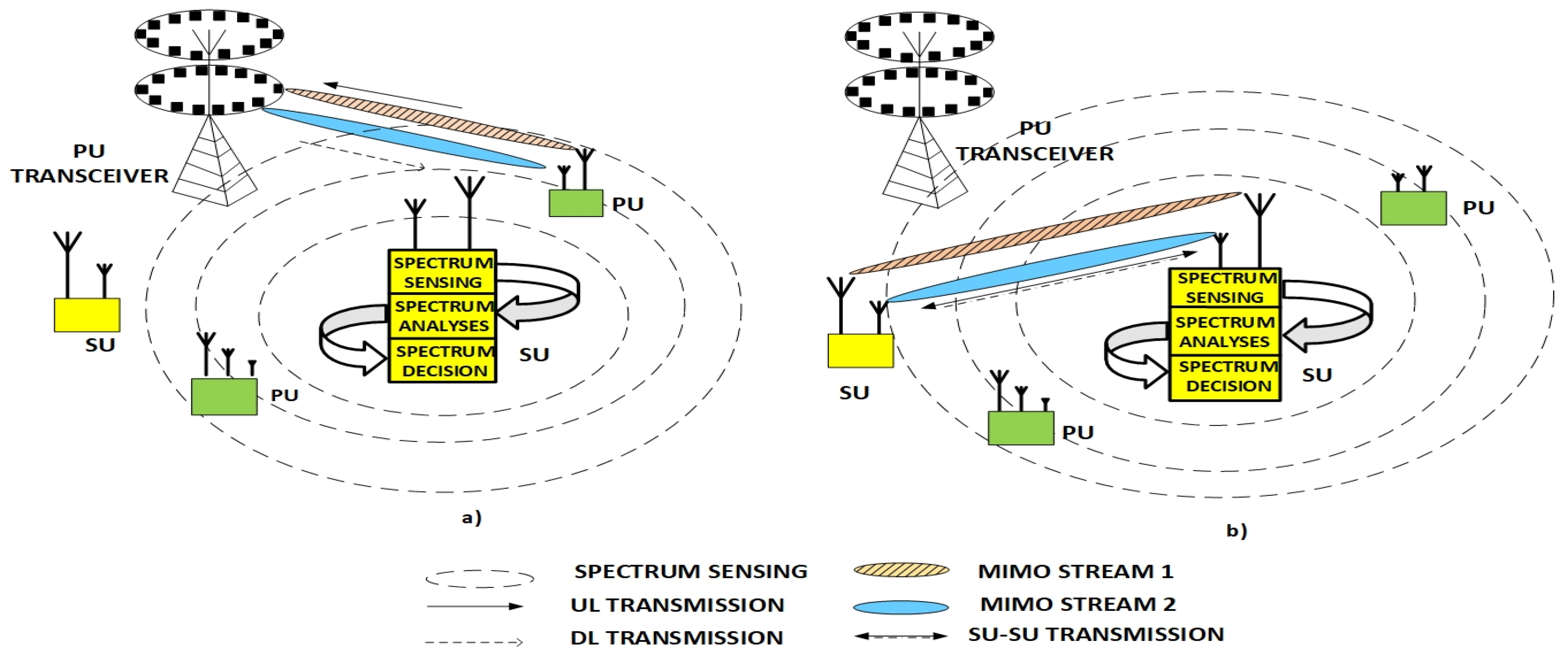
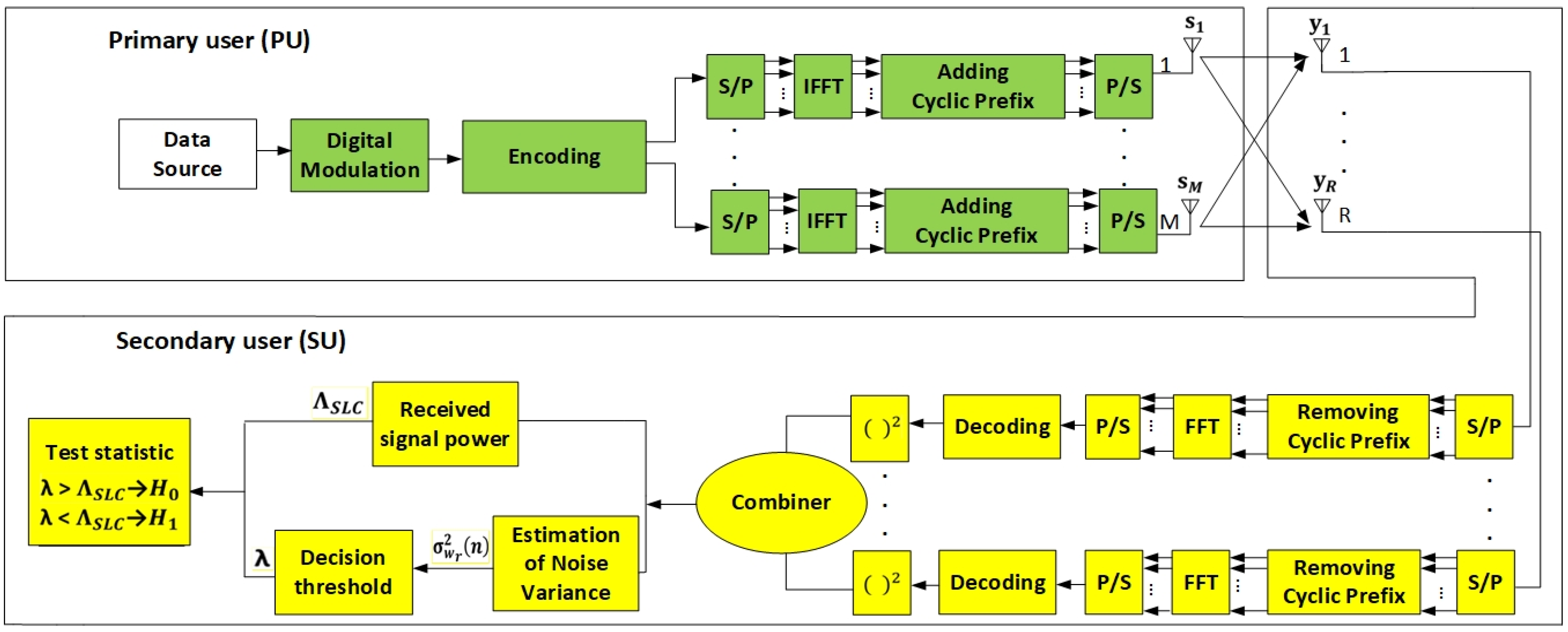

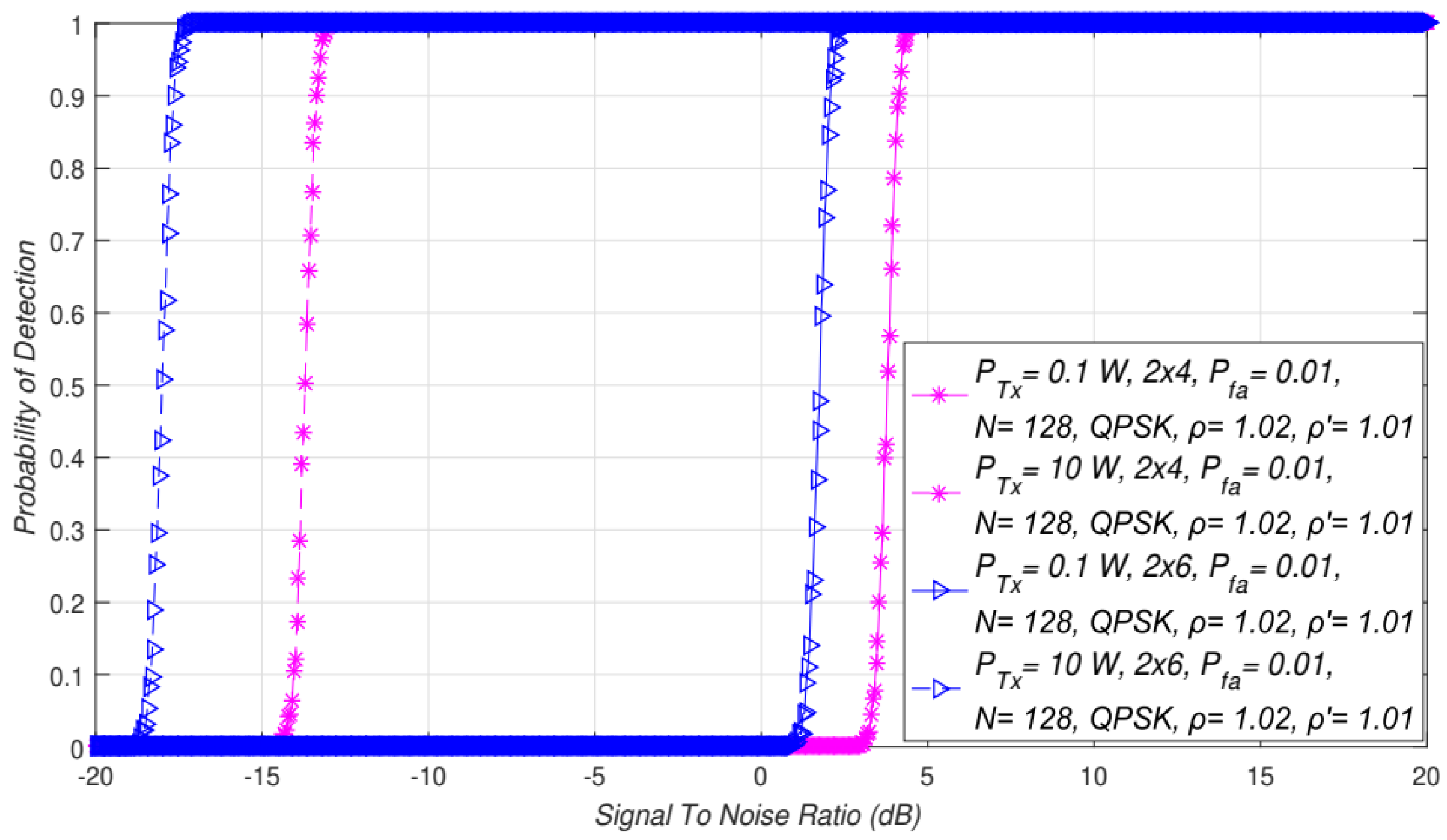

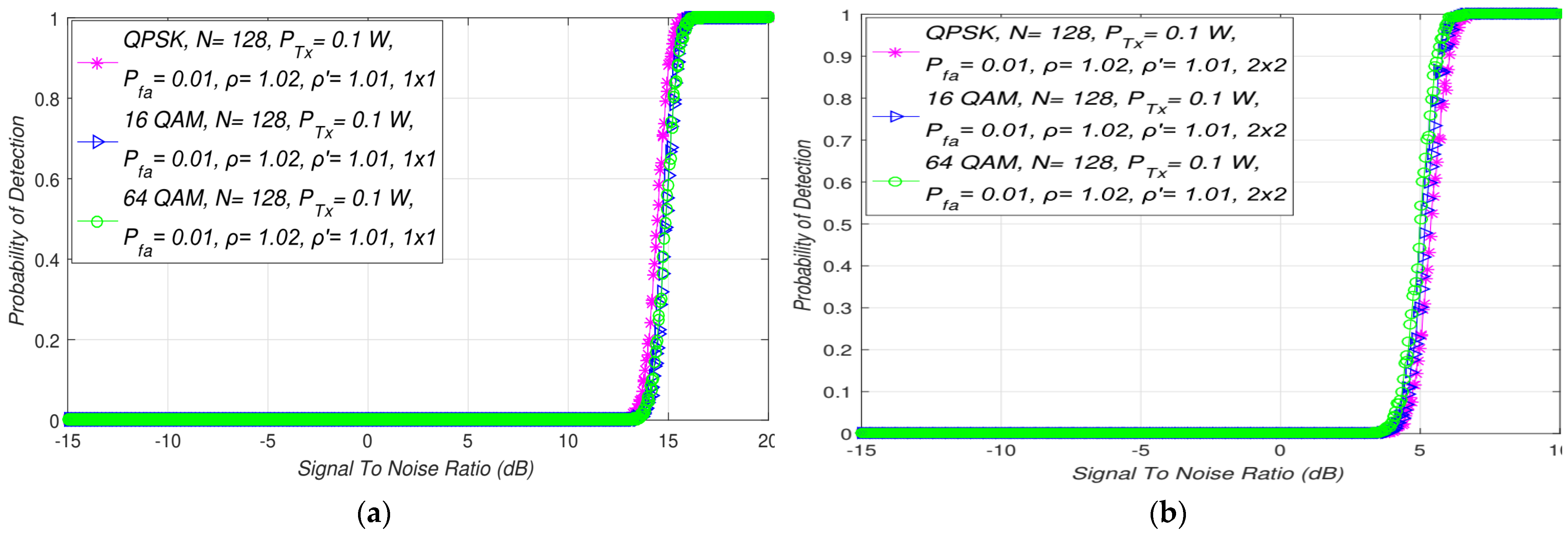

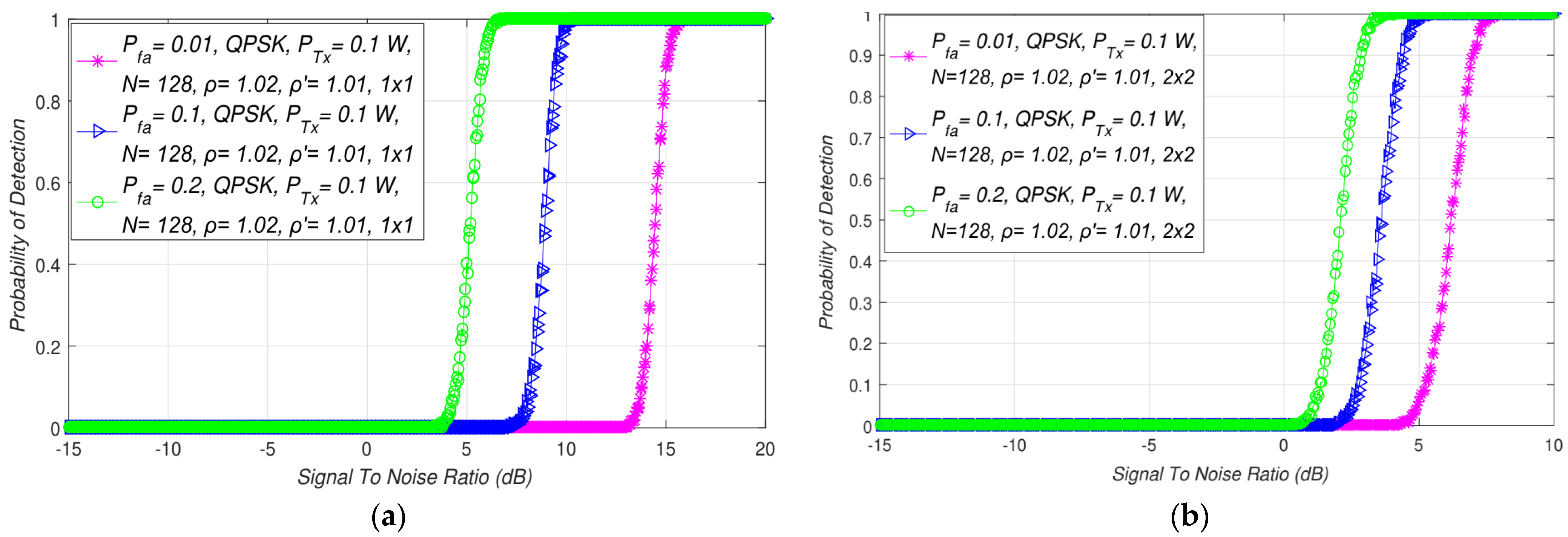

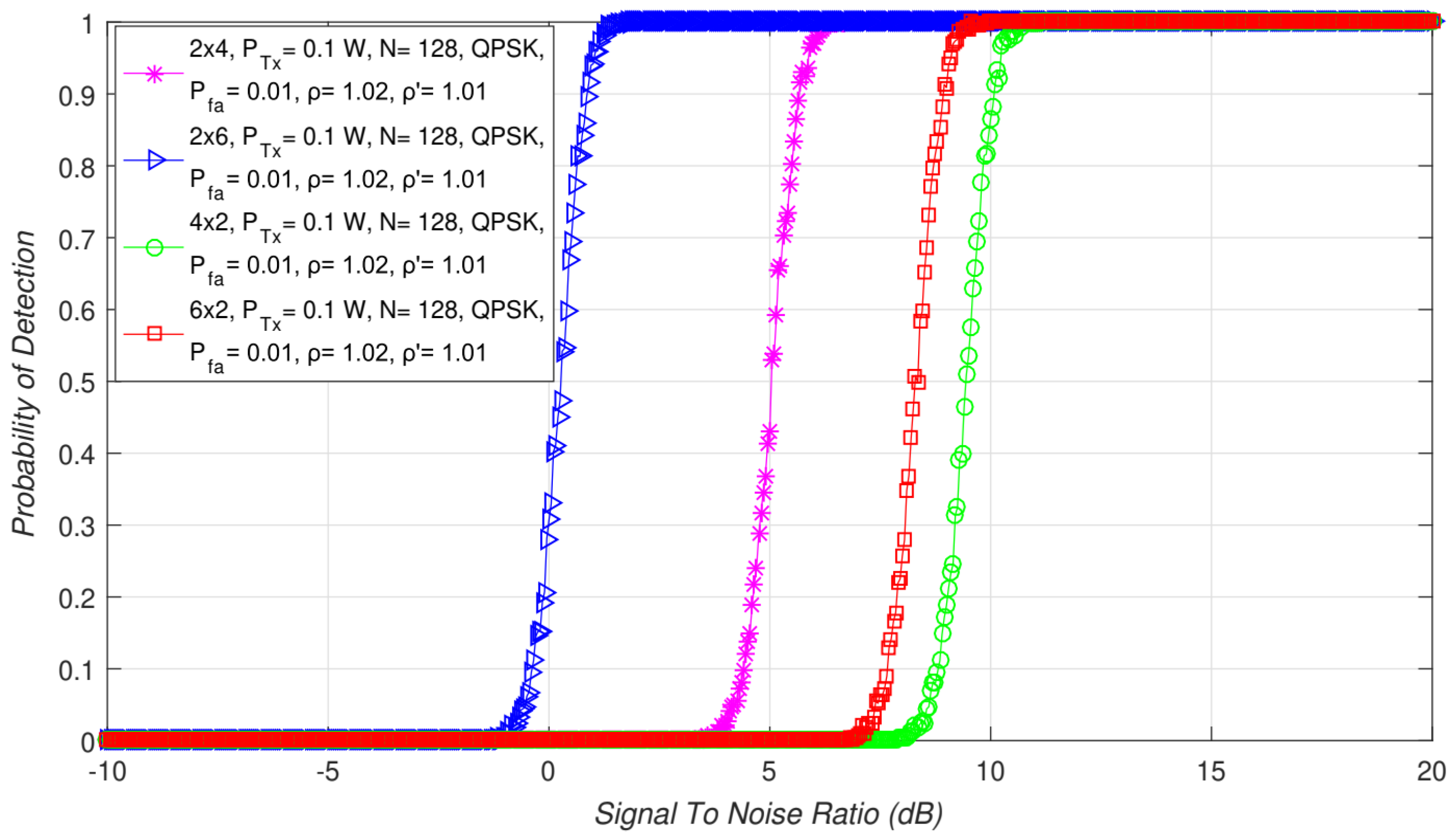
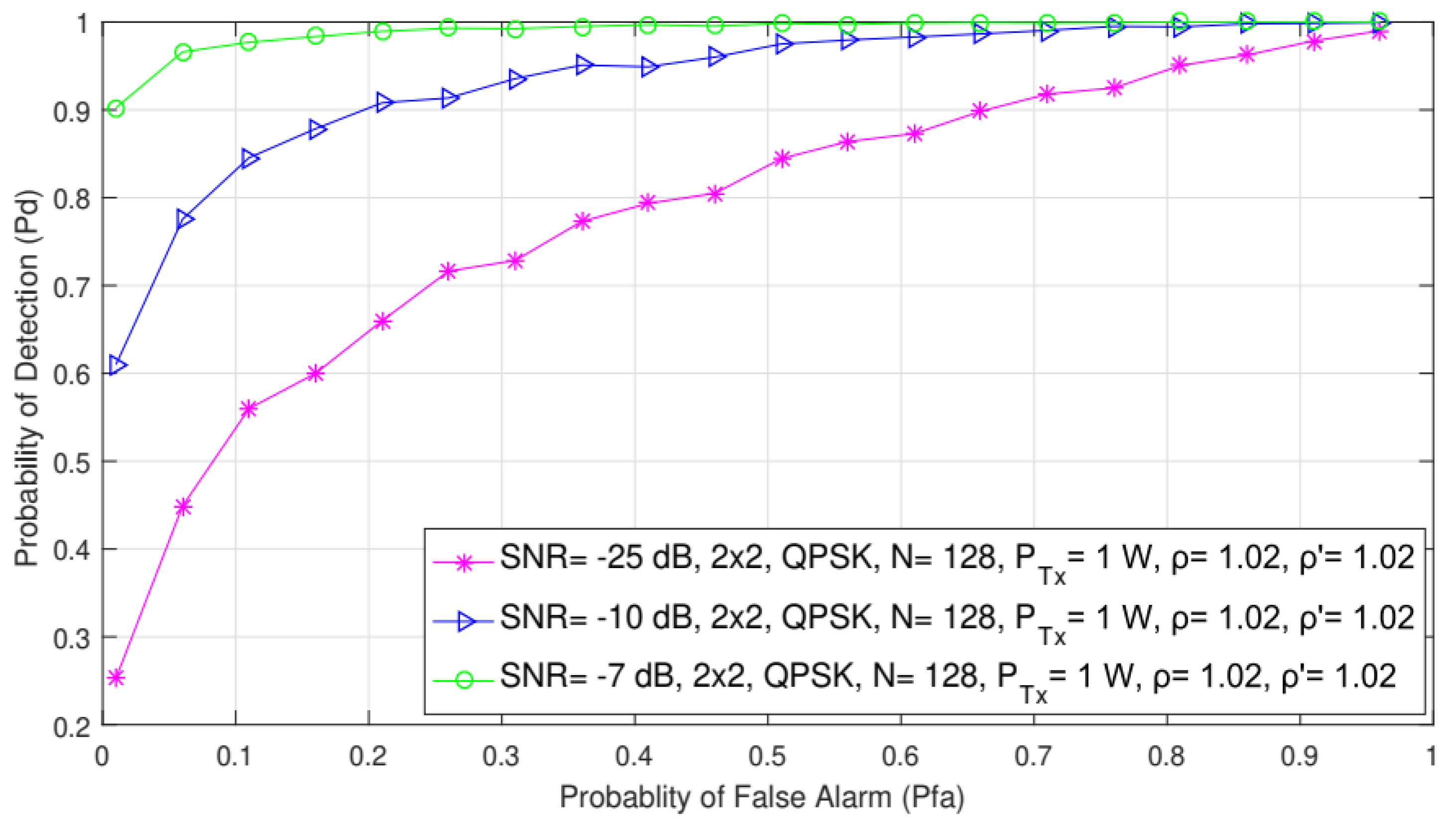
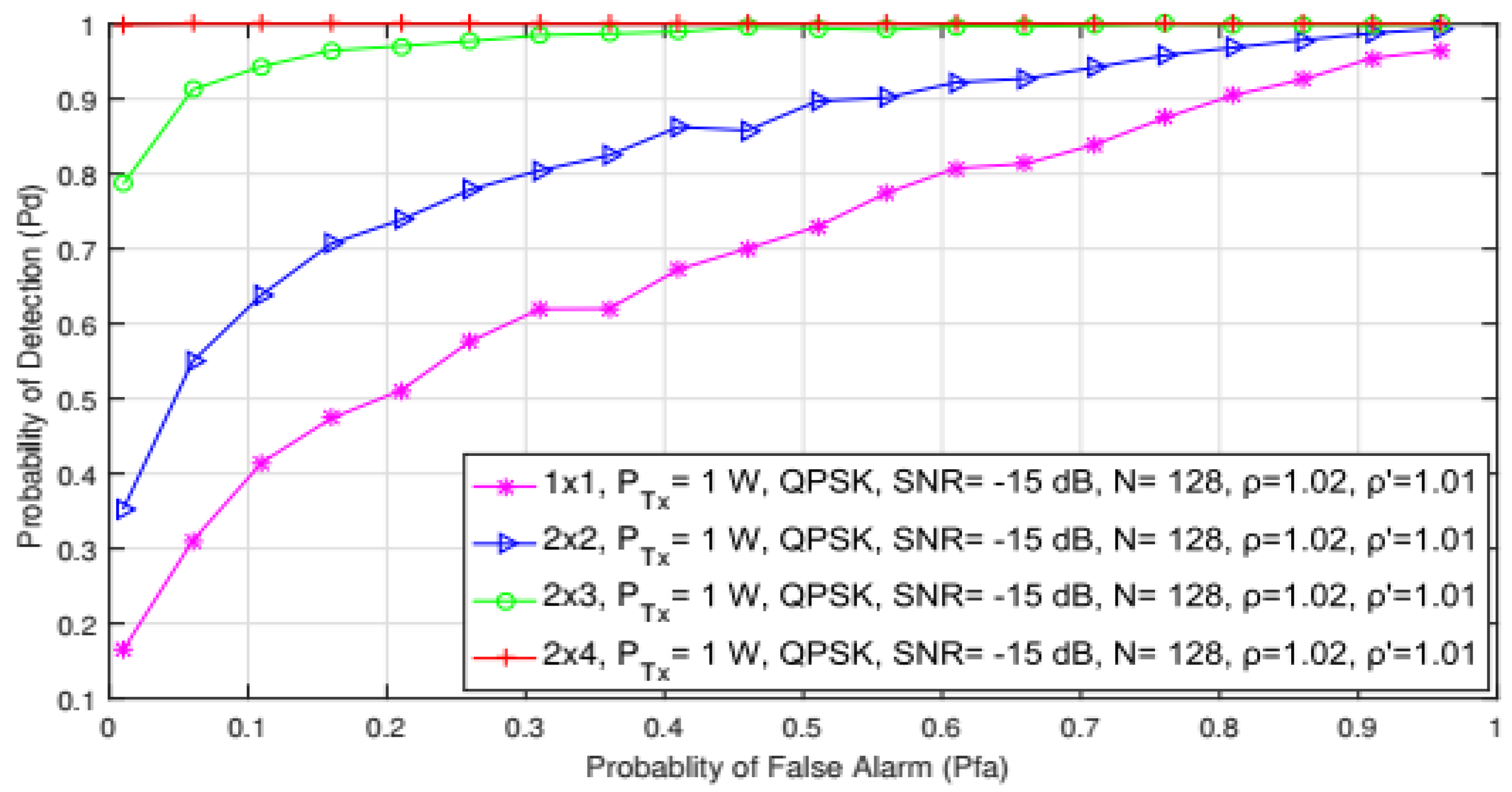
| Index | Description |
|---|---|
| The hypothesis that determines the presence of the PU signal | |
| The hypothesis that determines the absence of the PU signal | |
| m | Number of PU Tx branches (antennas) |
| r | Number of SU Rx branches (antennas) |
| M | Total number of transmit antennas at the PU |
| R | Total number of receiving antennas at the SU |
| N | Total number of samples used in the detection process |
| Transmit (Tx) power allocated through the m-th antenna element of the PU | |
| P | Total instantaneous Tx power of the PU transmitted over the M Tx branches |
| The complex signal transmitted over the m-th Tx antenna of the PU | |
| The overall complex signal transmitted by the PU from the M Tx branches | |
| The received signal at the r-th Rx branch (antenna) of the SU during the n-th spectrum-sensing period | |
| The overall signal received at the R Rx branches (antennas) of the SU during the n-th spectrum-sensing period | |
| ) during the n-th spectrum-sensing period | |
| received during the n-th sample at the r-th Tx branch (antenna) | |
| Complex noise vector at the r-th Rx branch (antenna) of the SU in the n-th spectrum-sensing period | |
| Nose variance of the signal detected at the r-th Rx antenna of the SU in the n-th spectrum-sensing period | |
| Received signal variance at the r-th Rx branch (antenna) of the SU in the n-th spectrum-sensing period | |
| SNR at the r-th antenna of the SU in the moment of the n-th spectrum-sensing period | |
| Total SNR associated with the M Rx antenna branches in the moment of the n-th spectrum-sensing period | |
| Average SNR detected at the location of the SU device for all R Rx antenna branches in the n-th spectrum-sensing period | |
| Test statistics of the signals received over the r-th Rx branch (antennas) of the SU device | |
| Total test statistics of the signals received over the R Rx branches (antennas) of the SU device | |
| Variance operation | |
| Expectation operation | |
| False alarm Probability | |
| Detection probability | |
| Gaussian-Q function | |
| Detection threshold | |
| False alarm detection threshold in the SLC ED systems | |
| ρ | NU factor |
| DT factor | |
| L | Number of channels used for transmission |
| Parameters | Type/Quantity |
|---|---|
| Transmission type of PU signal | OFDM |
| Number of transmit antennas | 1–4 |
| Number of receive antennas | 1–6 |
| Type of OFDM (constellation) | QPSK, 16 QAM, 64 QAM |
| Channel noise type | AWGN |
| Quantity N of samples (FFT size) | 128, 256, 512, 1024 |
| The range of SNRs at location of SU (dB) | −25–25 |
| The detection and false alarm probabilities’ range | 0–1 |
| No. of Monte Carlo iterations/simulation | 10,000 |
| NU factor ρ | 1.02 |
| DT factor ρ′ | 1.01 |
| Target False alarm probability | 0.01, 0.1, 0.2 |
| Total number of analysed MIMO-OFDM Tx-Rx configurations | 48 |
| Sim. Conf. No. | Simulation Configuration: No. of Tx/Rx Branches, Tx Power , False Alarm Probability Number of Samples (N), Modulation Type, NU/DT Coefficients | Exec. Time (µs) | Sim. Conf. No. | Simulation Configuration: No. of Tx/Rx Branches, Tx Power , False Alarm Probability , Number of Samples (N), Modulation Type, NU/DT Coefficients | Exec. Time (µs) |
|---|---|---|---|---|---|
| 1. | 1 × 1, 0.1 W, 0.01, 128, QPSK, 1.02/1.01 | 18 | 29. | 1 × 1, 0.1 W, 0.01, 128, QPSK, 1.02/1.01 | 15 |
| 2. | 2 × 2, 0.1 W, 0.01, 128, QPSK, 1.02/1.01 | 16 | 30. | 1 × 1, 0.1 W, 0.1, 128, QPSK, 1.02/1.01 | 19 |
| 3. | 3 × 3, 0.1 W, 0.01, 128, QPSK, 1.02/1.01 | 18 | 31. | 1 × 1, 0.1 W, 0.2, 128, QPSK, 1.02/1.01 | 26 |
| 4. | 4 × 4, 0.1 W, 0.01, 128, QPSK, 1.02/1.01 | 19 | 32. | 2 × 2, 0.1 W, 0.01, 128, QPSK, 1.02/1.01 | 22 |
| 5. | 2 × 4, 0.1 W, 0.01, 128, QPSK, 1.02/1.01 | 24 | 33. | 2 × 2, 0.1 W, 0.1, 128, QPSK, 1.02/1.01 | 28 |
| 6. | 2 × 4, 10 W, 0.01, 128, QPSK, 1.02/1.01 | 22 | 34. | 2 × 2, 0.1 W, 0.2, 128, QPSK, 1.02/1.01 | 21 |
| 7. | 2 × 6, 0.1 W, 0.01, 128, QPSK, 1.02/1.01 | 28 | 35. | 1 × 1, 0.1 W, 0.01, 128, 16 QAM, 1.02/1.01 | 18 |
| 8. | 2 × 6, 10 W, 0.01, 128, QPSK, 1.02/1.01 | 22 | 36. | 2 × 6, 0.1 W, 0.01, 128, 16 QAM, 1.02/1.01 | 15 |
| 9. | 1 × 1, 0.1 W, 0.01, 128, QPSK, 1.02/1.01 | 17 | 37. | 6 × 2, 0.1 W, 0.01, 128,16 QAM, 1.02/1.01 | 19 |
| 10. | 1 × 1, 0.1 W, 0.01, 256, QPSK, 1.02/1.01 | 33 | 38. | 2 × 4, 0.1 W, 0.01, 128, QPSK, 1.02/1.01 | 21 |
| 11. | 1 × 1, 0.1 W, 0.01, 512, QPSK, 1.02/1.01 | 41 | 39. | 2 × 6, 0.1 W, 0.01, 128, QPSK, 1.02/1.01 | 22 |
| 12. | 1 × 1, 0.1 W, 0.01, 1024, QPSK, 1.02/1.01 | 61 | 40. | 4 × 2, 0.1 W, 0.01, 128, QPSK, 1.02/1.01 | 29 |
| 13. | 2 × 2, 0.1 W, 0.01, 128, QPSK, 1.02/1.01 | 17 | 41. | 6 × 2, 0.1 W, 0.01, 128, QPSK, 1.02/1.01 | 22 |
| 14. | 2 × 2, 0.1 W, 0.01, 256, QPSK, 1.02/1.01 | 23 | Sim. Conf. No. | Simulation Configuration: No. of Tx/Rx Branches, Tx Power , SNR, Number of Samples (N), Modulation Type, NU/DT Coefficients | Exec. time (µs) |
| 15. | 2 × 2, 0.1 W, 0.01, 512, QPSK, 1.02/1.01 | 34 | |||
| 16 | 2 × 2, 0.1 W, 0.01, 1024, QPSK, 1.02/1.01 | 50 | |||
| 17. | 1 × 1, 0.1 W, 0.01, 128, QPSK, 1.02/1.01 | 28 | |||
| 18. | 1 × 1, 0.1 W, 0.01, 128, 16 QAM, 1.02/1.01 | 20 | 42. | 2 × 2, 1W, −25 dB, 128, QPSK, 1.02/1.01 | 49 |
| 19. | 1 × 1, 0.1 W, 0.01, 128, 64 QAM, 1.02/1.01 | 22 | 43. | 2 × 2, 1 W, −10 dB, 128, QPSK, 1.02/1.01 | 18 |
| 20. | 2 × 2, 0.1 W, 0.01, 128, QPSK, 1.02/1.01 | 21 | 44. | 2 × 2, 1 W, −7 dB, 128, QPSK, 1.02/1.01 | 34 |
| 21. | 2 × 2, 0.1 W, 0.01, 128, 16 QAM, 1.02/1.01 | 29 | 45. | 1 × 1, 1 W, −15 dB, 128, QPSK, 1.02/1.01 | 45 |
| 22. | 2 × 2, 0.1 W, 0.01, 128, 64 QAM, 1.02/1.01 | 22 | 46. | 2 × 2, 1 W, −15 dB, 128, QPSK, 1.02/1.01 | 15 |
| 23. | 1 × 1, 0.1 W, 0.01, 128, QPSK, 1.02/1.01 | 14 | 47. | 2 × 3, 1 W, 15 dB, 128, QPSK, 1.02/1.01 | 28 |
| 24. | 1 × 1, 10 W, 0.01, 128, QPSK, 1.02/1.01 | 16 | 48. | 2 × 4, 1W, −15 dB, 128, QPSK, 1.02/1.01 | 14 |
| 25. | 2 × 2, 0.1 W, 0.01, 128, QPSK, 1.02/1.01 | 18 | Minimal duration of execution time | 13 | |
| 26. | 2 × 2, 10 W, 0.01, 128, QPSK, 1.02/1.01 | 25 | Maximal duration of execution time | 61 | |
| 27. | 3 × 3, 0.1 W, 0.01, 128, QPSK, 1.02/1.01 | 14 | Average duration of execution time | 24.27 | |
| 28. | 3 × 3, 10 W, 0.01, 128, QPSK, 1.02/1.01 | 13 | Median duration of execution time | 22 |
Publisher’s Note: MDPI stays neutral with regard to jurisdictional claims in published maps and institutional affiliations. |
© 2021 by the authors. Licensee MDPI, Basel, Switzerland. This article is an open access article distributed under the terms and conditions of the Creative Commons Attribution (CC BY) license (https://creativecommons.org/licenses/by/4.0/).
Share and Cite
Lorincz, J.; Ramljak, I.; Begušić, D. Performance Analyses of Energy Detection Based on Square-Law Combining in MIMO-OFDM Cognitive Radio Networks. Sensors 2021, 21, 7678. https://doi.org/10.3390/s21227678
Lorincz J, Ramljak I, Begušić D. Performance Analyses of Energy Detection Based on Square-Law Combining in MIMO-OFDM Cognitive Radio Networks. Sensors. 2021; 21(22):7678. https://doi.org/10.3390/s21227678
Chicago/Turabian StyleLorincz, Josip, Ivana Ramljak, and Dinko Begušić. 2021. "Performance Analyses of Energy Detection Based on Square-Law Combining in MIMO-OFDM Cognitive Radio Networks" Sensors 21, no. 22: 7678. https://doi.org/10.3390/s21227678
APA StyleLorincz, J., Ramljak, I., & Begušić, D. (2021). Performance Analyses of Energy Detection Based on Square-Law Combining in MIMO-OFDM Cognitive Radio Networks. Sensors, 21(22), 7678. https://doi.org/10.3390/s21227678







